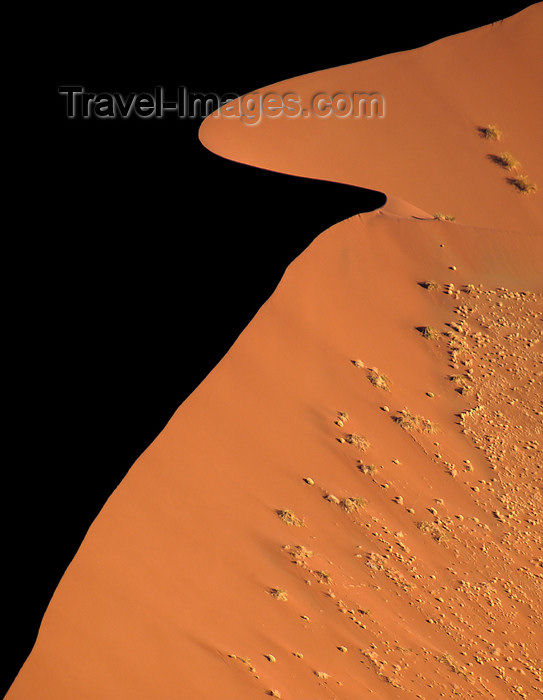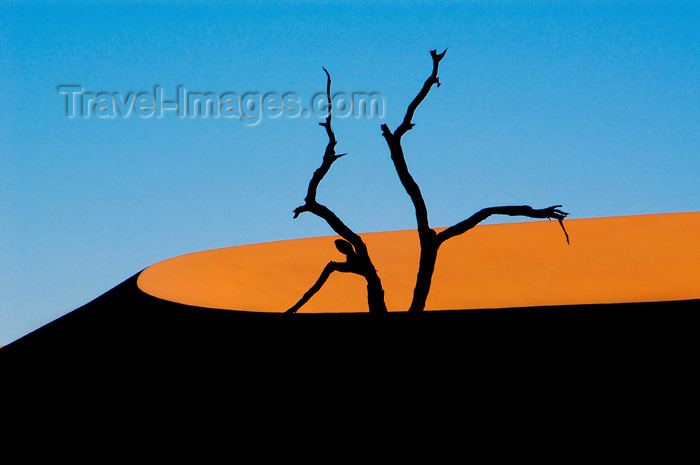| Travel
Articles for Publishers |
Travel-Images.com
|
|
|
The travel article below
is available for publishing, with or without photos (more
images available). Please contact us
with details about your publication for a detailed quote. Both this article
and all the images are copyrighted. Other travel
articles are also available for publishing.
Namibia: Dawn at Deadvlei
by Bill Cain
 A
4:00 am wakeup call is necessary in order to reach Deadvlei in time for
sunrise. That’s the requirement from the Little Kulala Lodge at which I
was staying just outside Sossusvlei in the Namib Naukluft National Park
in central Namibia. An hour after sunrise and the magic of the low sun
on the horizon has slipped away, and with it the unique photo opportunities
that serious photographers from all over the world come to this corner
of the Namib Desert to capture.
A
4:00 am wakeup call is necessary in order to reach Deadvlei in time for
sunrise. That’s the requirement from the Little Kulala Lodge at which I
was staying just outside Sossusvlei in the Namib Naukluft National Park
in central Namibia. An hour after sunrise and the magic of the low sun
on the horizon has slipped away, and with it the unique photo opportunities
that serious photographers from all over the world come to this corner
of the Namib Desert to capture.
The literal translation of Sossusvlei means
open place of nothingness, but in actuality, nothing could be further from
the truth because the world’s oldest, highest and perhaps its most beautiful
sand dunes are to be found here and have become Namibia’s signature attraction.
Covering an area of over 4,300 square miles, it would take a life time
to explore the thousands of dunes that have been shaping and shifting over
the millennia. Fortunately, there are a several dozen or so that have been
identified as some of the most unusual and awe-inspiring and they, along
with the added attraction of Deadvlei, are also conveniently situated for
the average tourist to see and explore in a day or two.
A group of several small but comfortable
lodges have sprung up on the other side of the protected national park
border and there’s an area within the park that can easily be driven with
a four wheel drive vehicle. An ancient dry river bed about a half mile
wide now provides an opportune 25-mile long finger of flat scrub, both
sides of which are lined with some of the most wondrous and captivating
naturally sculpted sand on the planet.
An attempt to number the most important
dunes has ended, at least temporarily, with Dune # 45 which, for those
on a tight schedule, can be seen relatively soon after beginning the drive
down “dune alley”. At the other end where the road dissolves into the sand
is “Big Daddy”, across from which is “Big Mama” – two of the more massive
dunes, but neither of which is the highest. That distinction belongs to
a dune topping off at 200 feet from the base where, unlike mountains, the
dunes are measured. But, like mountains, they beg to be climbed, especially
barefoot, and scaling any of the major dunes requires just as much strength
and stamina. It takes a physically fit person 2-3 hours to tackle “Big
Daddy” and the climb is more demanding than climbing a solid mountain of
rock. For every three steps forward, the equivalent of one step backwards
in the soft sand has to be anticipated. Routes can only be negotiated along
the wind swept ridge lines, some of which sweep through several switchbacks,
making the climbs much longer than they appear from the roadway. Going
directly straight up a dune is virtually impossible, but running straight
down, causing mini landslide in the process, is the fun reward after the
tough ascent. Lest one thinks the beauty of the dunes is continually under
assault from the constant barrage of foot traffic, one windy day is all
that’s needed to restore the dunes to their original pristine condition.
Most people flock to the dunes at sunrise
when the low sun angle transforms them into a tantalizing combination of
black scalloped shadows and deep red feminine sensuality. As the sun climbs
in the sky, the shadows fade and the color hews shift. Even though the
sand is all the same consistency, different light at various angles of
view creates a medley of effects. From one midday vantage point, there
can be creamy coffee-colored dunes to the right, burnt umber ones to the
left and those with an orangey tangerine flavor straight ahead.
As captivating as the dunes are when experienced
from up close at ground level, their collective grandeur and immense expanse
is best appreciated from a bird’s eye view. Hot air balloon flights on
most mornings drift up to twelve passengers each over an ocean of swirled
sand, dwarfing the tiny chase vehicles below as they slalom between the
dunes to keep up. The best aerial advantage, though, is from a light aircraft.
I had the good fortune to have flown into and out of the region and, while
the fly in came from the wrong direction for dune viewing, the flight out
more than compensated as it ran the entire length of dune ally and the
next 100 miles over a sea of undulating and abstract formations at low
altitude.
 Just
before the end of dune ally, a short unmarked hike over a few small dunes
leads the lucky, informed few to the dead place, or Deadvlei. It’s hard
to imagine that an area so desolate and baron could be so enchantingly
stunning. Tucked away in a valley surrounded by “Big Daddy” and other enormous
dunes, a flat, dried out and bleached white pan, craquelured into a haphazard
network of fissures, harbors several dozen dead acacia trees, their creepy,
twisted branches resembling something out of a Sleepy Hollow story on Halloween.
Some of the trees are estimated to be 500 – 800 years old, having been
remarkably preserved for the centuries by the dry desert air. At the magic
hour of dawn the trees are silhouetted and their juxtaposition against
the layers of what are then apricot and lemon colored dunes with a powder
blue sky can send a photographer into a state of nirvana.
Just
before the end of dune ally, a short unmarked hike over a few small dunes
leads the lucky, informed few to the dead place, or Deadvlei. It’s hard
to imagine that an area so desolate and baron could be so enchantingly
stunning. Tucked away in a valley surrounded by “Big Daddy” and other enormous
dunes, a flat, dried out and bleached white pan, craquelured into a haphazard
network of fissures, harbors several dozen dead acacia trees, their creepy,
twisted branches resembling something out of a Sleepy Hollow story on Halloween.
Some of the trees are estimated to be 500 – 800 years old, having been
remarkably preserved for the centuries by the dry desert air. At the magic
hour of dawn the trees are silhouetted and their juxtaposition against
the layers of what are then apricot and lemon colored dunes with a powder
blue sky can send a photographer into a state of nirvana.
After leaving Deadvlei with far too many
photographs that I could ever hope to use, the balance of the day was spent
frolicking among the dunes, watching a few intrepid fools trying to climb
“Big Mama” in the oppressive midday heat and pic nicking under the shade
of a live acacia tree. Returning to the lodge later that day, I knew that
the next morning I’d be able to sleep in a bit. The wakeup call for sunrise
at Dune # 45 wouldn’t be until 5:00 am.
| Travel Articles |
www.travel-images.com
|
 A
4:00 am wakeup call is necessary in order to reach Deadvlei in time for
sunrise. That’s the requirement from the Little Kulala Lodge at which I
was staying just outside Sossusvlei in the Namib Naukluft National Park
in central Namibia. An hour after sunrise and the magic of the low sun
on the horizon has slipped away, and with it the unique photo opportunities
that serious photographers from all over the world come to this corner
of the Namib Desert to capture.
A
4:00 am wakeup call is necessary in order to reach Deadvlei in time for
sunrise. That’s the requirement from the Little Kulala Lodge at which I
was staying just outside Sossusvlei in the Namib Naukluft National Park
in central Namibia. An hour after sunrise and the magic of the low sun
on the horizon has slipped away, and with it the unique photo opportunities
that serious photographers from all over the world come to this corner
of the Namib Desert to capture.
 Just
before the end of dune ally, a short unmarked hike over a few small dunes
leads the lucky, informed few to the dead place, or Deadvlei. It’s hard
to imagine that an area so desolate and baron could be so enchantingly
stunning. Tucked away in a valley surrounded by “Big Daddy” and other enormous
dunes, a flat, dried out and bleached white pan, craquelured into a haphazard
network of fissures, harbors several dozen dead acacia trees, their creepy,
twisted branches resembling something out of a Sleepy Hollow story on Halloween.
Some of the trees are estimated to be 500 – 800 years old, having been
remarkably preserved for the centuries by the dry desert air. At the magic
hour of dawn the trees are silhouetted and their juxtaposition against
the layers of what are then apricot and lemon colored dunes with a powder
blue sky can send a photographer into a state of nirvana.
Just
before the end of dune ally, a short unmarked hike over a few small dunes
leads the lucky, informed few to the dead place, or Deadvlei. It’s hard
to imagine that an area so desolate and baron could be so enchantingly
stunning. Tucked away in a valley surrounded by “Big Daddy” and other enormous
dunes, a flat, dried out and bleached white pan, craquelured into a haphazard
network of fissures, harbors several dozen dead acacia trees, their creepy,
twisted branches resembling something out of a Sleepy Hollow story on Halloween.
Some of the trees are estimated to be 500 – 800 years old, having been
remarkably preserved for the centuries by the dry desert air. At the magic
hour of dawn the trees are silhouetted and their juxtaposition against
the layers of what are then apricot and lemon colored dunes with a powder
blue sky can send a photographer into a state of nirvana.